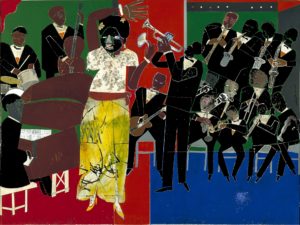How African Americans Influenced Delaware’s Art and Music Scene
As Black History Month continues, I gave thought to African Americans from my little state of Delaware. Many people are unaware of the people who came from Delaware or visited here often. There are interesting historical accounts of Black men and women who were abolitionists, Underground Railroad stationmasters, distinguished lawyers, authors and more. In 1950, Who’s Who in Colored America included 10 Delawareans from various professions. But there was something else taking shape at the very fiber of Delaware’s music and arts scene. Three of the more popular individuals in the arts scene who made Delaware their home at one time were Bob Marley, Clifford Brown, and Edward Loper.
My first person of tribute is Edward L. Loper Sr. (April 7, 1916 – October 11, 2011) a Black artist known for his vibrant palette and juxtaposition of colors. He went on to teach painting for almost 70 years. In 1937, Loper became the first African American to have a painting accepted by the Wilmington Society of the Fine Arts (now the Delaware Art Museum). The University of Delaware has all of Loper’s works in his possession at the time of his death. There was a special relationship with the University after he exhibited a painting there in 1941 at a time when African Americans were not even attending the university due to this country’s segregation. To this day, his work continues to be housed in the University of Delaware’s Paul R. Jones Collection of African-American Art, the Delaware Art Museum, the Biggs Museum of Art, and the Christina Cultural Arts Center among many others nationally. Two of Loper’s paintings hung in (formerly Vice President) Joe Biden’s official residence at Number One Observatory Circle in Washington, DC. as well. He still has some family in the state.
Another famous person, Clifford Brown (October 30, 1930 – June 26, 1956) lived and played in Delaware. Brown, a trumpeter and one of the most influential jazz musicians of the mid-20th century, was born in Wilmington. He was playing in Philadelphia with pioneering jazz performers such as Fats Navarro, Dizzy Gillespie, and Charlie Parker by the age of eighteen. Brown recorded albums outside of the quintet, including the Pacific Coast Jazz session and two albums with jazz vocalist Dinah Washington. His legacy included four years’ worth of recordings. His body of work included “Sandu”, “Joy Spring”, and “Daahoud” which became jazz standards. Tragically he lost his life in a car accident at just twenty-five, in the summer of 1956, but his music lives on. The Clifford Brown Jazz Festival, held annually in downtown Wilmington, is the largest free jazz festival on the East Coast. This multi-day outdoor music festival rivals Cape May’s popular event except the artists at this one pay tribute to Clifford Brown’s magnificent work.
His reputation and life legacy was about more than his talent too. Several artists were known to comment on how Brown stayed away from drugs and wasn’t fond of alcohol. Rollins, who was recovering from heroin addiction, said “Clifford was a profound influence on my personal life. He showed me that it was possible to live a good, clean life and still be a good jazz musician!” Even Jazz historian Ira Gitler said of Brown, “I’m sorry I never got to know him better. Not that it necessarily follows that one who plays that beautifully is also a marvelous person, but one can discern in Clifford Brown’s case that the particular kind of extraordinary playing was linked to an equally special human being.” He is also buried here in Delaware, and you can visit the grave at the Mt. Zion Cemetery where there is a historical marker with his name.
Finally, I’d assume the most famous person I’m mentioning—Bob Marley (February 6, 1945 – May 11, 1981) made Delaware his home for a time. He moved here, specifically to Wilmington where his mother had already arrived, and lived off and on between 1965 and 1977. He held several jobs in Greater Wilmington including a position at the Chrysler Assembly Plant. Two of Marley’s friends, Ibis and Genny Pitts, shared with Delaware Online a few years ago some memories of how they met and befriended him. They had no idea the legend he was going to become! When Ibis met Marley, he was gifted a small record of his 1967 song with the Wailers, “Nice Time.” At home, Ibis had an opportunity to play drums in the basement while Marley played guitar.
“We’d jam, but I didn’t really know who he was at that point,” Ibis says. “We were just having fun.”
The 24-year-old future Reggae icon was remembered by his friend as someone who, “…kept a very low, low profile.” Marley refused to attend Woodstock with his friend and wasn’t fond of going to many places in order to write his music and spending time with family. Ibis continued, “I later got him to go with me one time to see my mother in New Jersey and I was so happy he did that!” Later, in 1969, Ibis went with Marley to Jamaica when his visa expired. It was Ibis’ first time in Jamaica, and he soon found himself in Trenchtown. When he walked the dirt roads with Marley, he said people would follow behind them. “It was like Jesus with his disciples!” At night, Marley and the Wailers would all gather and play music. “And I still didn’t know what this man was going to be,” says Ibis, thinking on those nights in Jamaica nearly decades ago. “We were just jammin’…” As various festivals roll around this summer, I’ll reflect upon Clifford Brown’s legacy as a young talented Black musician who inspired others, also Bob Marley as an artist with contributions made to Reggae and to the world, and Edward Loper’s strides to pave the way for Black artists all over the United States.


